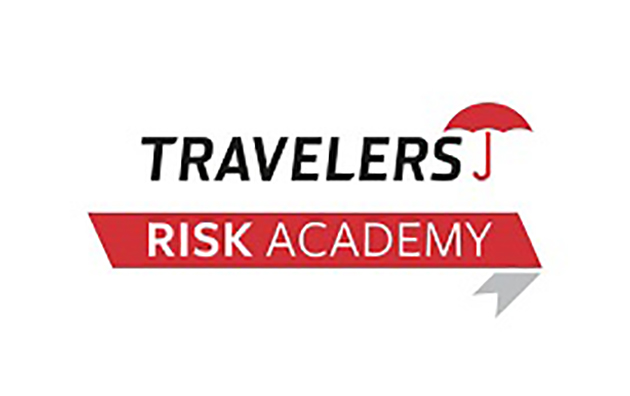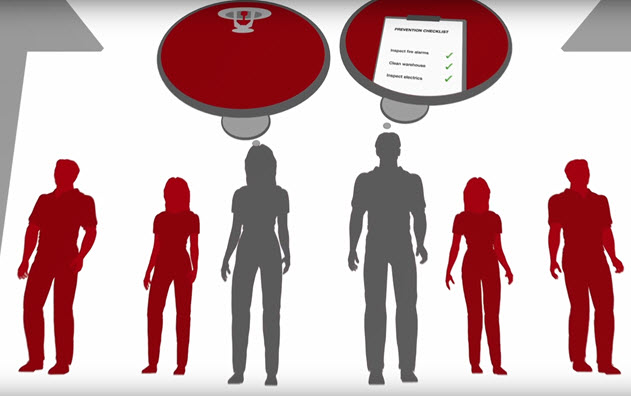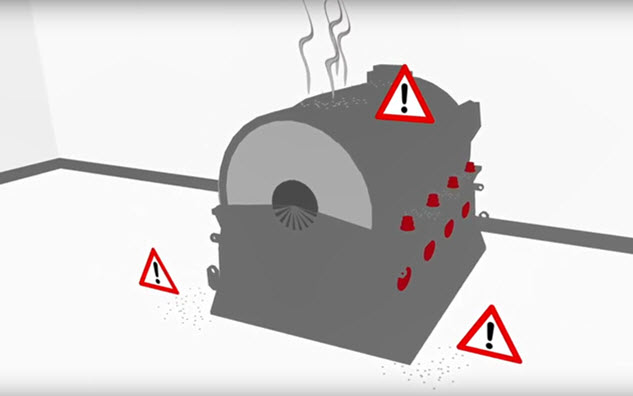How to Prevent Slips, Trips and Falls

(DESCRIPTION)
A man in a building lobby walks toward a vacuum cord across the floor and looks down at it, then looks up.
(SPEECH)
Trips and slips are the most common cause of injury at work and the most reported injury to members of the public. On average, they cause 40% of all major injuries reported to the Health and Safety Executive.
[ROUSING MUSIC]
(DESCRIPTION)
Logo and text: TRAVELERS. Prevent Slips, Trips and Falls. Animation: A woman walks across a room, slips on a puddle and falls backward.
(SPEECH)
Injuries caused by slips, trips, and falls can affect both employees and visitors to your premises. The good news is most are preventable.
(DESCRIPTION)
A man holds up a clipboard with a Safety Checklist.
(SPEECH)
A safety programme that includes routine inspection and maintenance is essential. Just walking through your premises with an eye on safety can highlight dangers before they become an accident.
(DESCRIPTION)
A worker reaches up and installs a light bulb.
(SPEECH)
Walkways should be kept clear, properly lit, and flooring surfaces in good order. Identify and repair defective and uneven surfaces.
(DESCRIPTION)
A worker removes a damaged tile and replaces it.
(SPEECH)
Get spills cleaned up fast and use wet floor signs.
(DESCRIPTION)
A worker mops up a spill next to a sign that says Caution, Wet Floor.
(SPEECH)
A slip-resistant surface is a good idea in areas that are regularly wet.
Good design and regular maintenance prevents most accidents, but when they do happen, make sure they are properly investigated and recorded. To find out more, visit the website below or speak to your broker.
(DESCRIPTION)
Text: www.travelers.co.uk/riskcontrol. Next Tip (with a video Play button icon. Share the Safety. in. Get more safety tips at www.travelers.co.uk/riskcontrol. The information in this video is intended as a guideline and it not intended as, nor does is constitute legal, technical or professional advice. Travelers does not warrant that adherence to any recommendations, best practices, or guidelines will result in a particular outcome. In no event will Travelers or any of its subsidiaries or affiliates be liable to anyone who has access to or uses the information provided in the video. Copyright 2016 Travelers Management Limited. Travelers and the Travelers Umbrella logo are registered trademarks of The Travelers Indemnity Company in the U.S. and other countries.
Good practice on workplace health and safety
Slips, trips and falls are a major cause of injury in the workplace. For any organisation with significant footfall, the risk of injury to employees and visitors is a significant concern, particularly where unsafe conditions exist. It is often thought that slips, trips and falls 'just happen,' but there are a number of actions that can be taken to prevent them.
The risks associated with slips, trips and falls are numerous, so it is important to understand where the greatest potential for danger lies. Some slips, trips and falls hazards include:
- Slippery surfaces, such as polished tiles.
- Broken or uneven surfaces.
- Wet and slippery surfaces caused by adverse weather, spills or poor drainage.
- Poorly marked and poorly lit walkways.
Managing the risks of slips, trips and falls
The following steps should be taken to keep the walkways safe:
- Choose appropriate slip resistant flooring and drainage for the environmental conditions that will be present.
- Do not wax, polish or treat floors in any way that compromises their slip resistance.
- Clean up spills immediately and put a wet floor sign up until the area is dry.
- In wet weather, ensure that walk off mats are provided and kept in good condition to avoid becoming a trip hazard.
- Keep walkways clear to avoid trip hazards.
- Ensure aisles and passageways are adequately illuminated.
- Regularly inspect and maintain all floor surfaces.
Reporting and investigating incidents
Even in the best run businesses, incidents can happen. The actions you take after an incident can make a big difference to preventing future incidents or potential exposure to any liability. Some key considerations include:
- Accurately document the circumstances of the incident, including taking relevant photographs, or reviewing CCTV footage.
- Make a note of any witnesses and take witness accounts.
- Record any relevant environmental details, for example wet surfaces, weather conditions and uneven floors.
- Take any remedial actions, based upon the findings.
For more information, sign up to our Risk Academy, log in to the Risk Control Customer Portal, or email [email protected].



